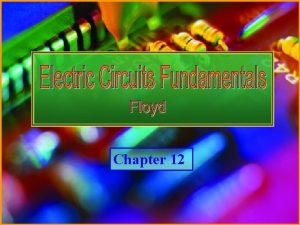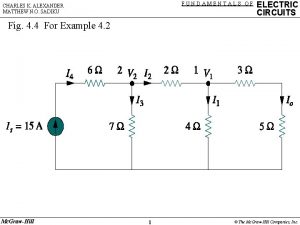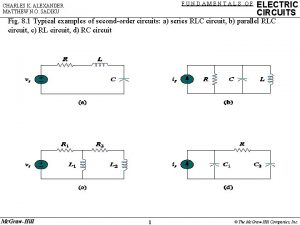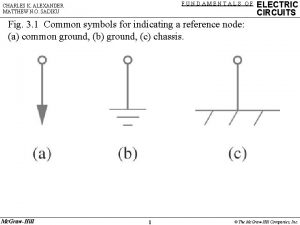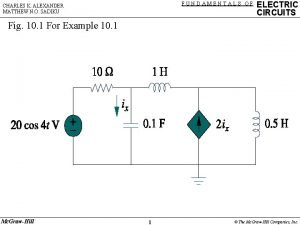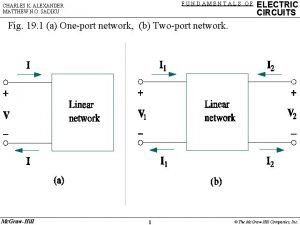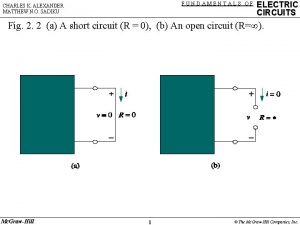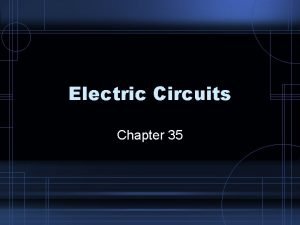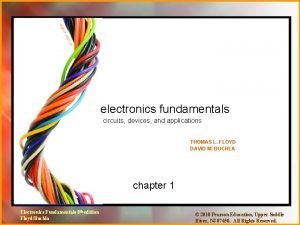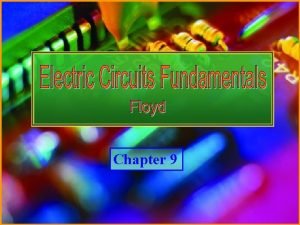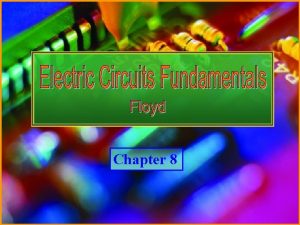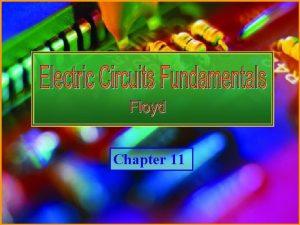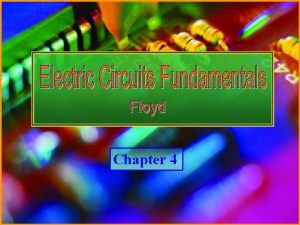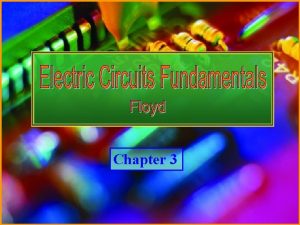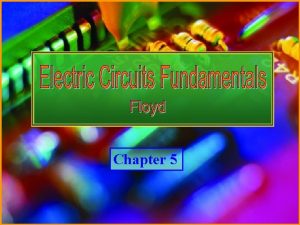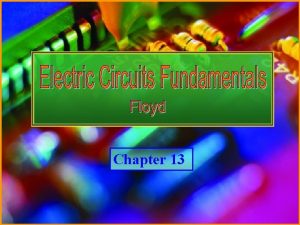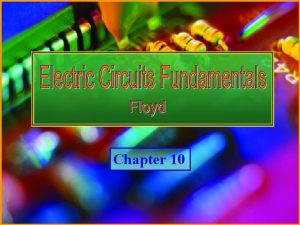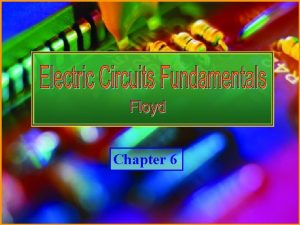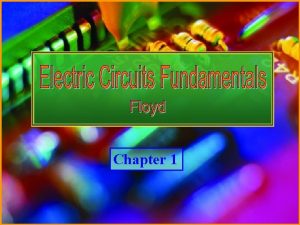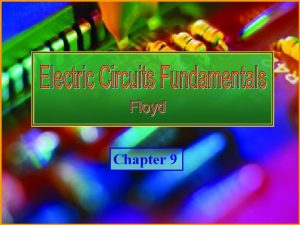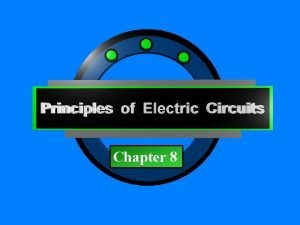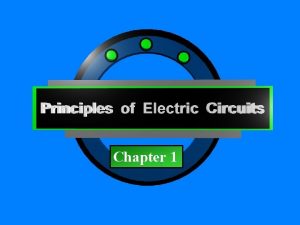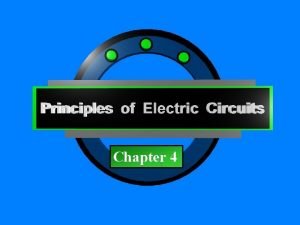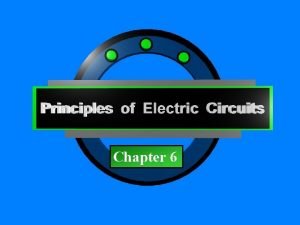Chapter 3 Electric Circuits Fundamentals Floyd Copyright 2007






















- Slides: 22

Chapter 3 Electric Circuits Fundamentals - Floyd © Copyright 2007 Prentice-Hall

Chapter 3 Summary Review of V, I, and R Voltage is the amount of energy per charge available to move electrons from one point to another in a circuit and is measured in volts. Current is the rate of charge flow and is measured in amperes. Resistance is the opposition to current and is measured in ohms. Electric Circuits Fundamentals - Floyd © Copyright 2007 Prentice-Hall

Chapter 3 Summary Ohm’s law The most important fundamental law in electronics is Ohm’s law, which relates voltage, current, and resistance. Georg Simon Ohm (1787 -1854) formulated the equation that bears his name: What is the current in a circuit with a 12 V source if the resistance is 10 W? 1. 2 A Electric Circuits Fundamentals - Floyd © Copyright 2007 Prentice-Hall

Chapter 3 Summary Ohm’s law If you need to solve for voltage, Ohm’s law is: What is the voltage across a 680 W resistor if the current is 26. 5 m. A? 18 V Electric Circuits Fundamentals - Floyd © Copyright 2007 Prentice-Hall

Chapter 3 Summary Ohm’s law If you need to solve for resistance, Ohm’s law is: What is the (hot) resistance of the bulb? 132 W 115 V Electric Circuits Fundamentals - Floyd © Copyright 2007 Prentice-Hall

Chapter 3 Summary A student takes data for a resistor and fits the straight line shown to the data. What is the conductance and the resistance of the resistor? The slope represents the conductance. The reciprocal of the conductance is the resistance: Electric Circuits Fundamentals - Floyd © Copyright 2007 Prentice-Hall

Chapter 3 Summary Graph of Current versus Voltage Notice that the plot of current versus voltage for a fixed resistor is a line with a positive slope. What is the resistance indicated by the graph? 2. 7 k. W What is its conductance? 0. 37 m. S Electric Circuits Fundamentals - Floyd © Copyright 2007 Prentice-Hall

Chapter 3 Summary Graph of Current versus Resistance If resistance is varied for a constant voltage, the current versus resistance curve plots a hyperbola. What is the curve for a 3 V source? Electric Circuits Fundamentals - Floyd © Copyright 2007 Prentice-Hall

Chapter 3 Summary Application of Ohm’s law 26. 8 m. A The resistor is green-blue brown-gold. What should the ammeter read? R=560± 5%Ω I=15 V/560 =26. 8 m. A Electric Circuits Fundamentals - Floyd © Copyright 2007 Prentice-Hall

Chapter 3 Summary Energy and Power When a constant force is applied to move an object over a distance, the work is the force times the distance. The force must be measured in the same direction as the distance. The unit for work is the newton-meter (N -m) or joule (J). Distance Force Electric Circuits Fundamentals - Floyd © Copyright 2007 Prentice-Hall

Chapter 3 Summary Energy and Power One joule is the work done when a force of one newton is applied through a distance of one meter. A joule is a small amount of work approximately equal to the work done in raising an apple over a distance of 1 m. 1 m The symbol for energy, W, represents work, but should not be confused with the unit for power, the watt, W. Electric Circuits Fundamentals - Floyd © Copyright 2007 Prentice-Hall

Chapter 3 Summary Energy and Power Energy is closely related to work. Energy is the ability to do work. As such, it is measured in the same units as work, namely the newton-meter (N-m) or joule (J). What amount of energy is converted to heat in sliding a box along a floor for 5 meters if the force to move it is 400 n? W = Fd = (400 N)(5 m) = 2000 N-m = 2000 J Electric Circuits Fundamentals - Floyd © Copyright 2007 Prentice-Hall

Chapter 3 Summary Energy and Power is the rate of doing work. Because it is a rate, a time unit is required. The unit is the joule per second (J/s), which defines a watt (W). What power is developed if the box in the previous example is moved in 10 s? 200 W Electric Circuits Fundamentals - Floyd © Copyright 2007 Prentice-Hall

Chapter 3 Summary Energy and Power The kilowatt-hour (k. Wh) is a much larger unit of energy than the joule. There are 3. 6 x 106 J in a k. Wh. The k. Wh is convenient for electrical appliances. What is the energy used in operating a 1200 W heater for 20 minutes? 1200 W = 1. 2 k. W 20 min = 1/3 h 1. 2 k. W X 1/3 h = 0. 4 k. Wh Electric Circuits Fundamentals - Floyd © Copyright 2007 Prentice-Hall

Chapter 3 Summary Energy and Power In electrical work, the rate energy is dissipated can be determined from any of three forms of the power formula. Together, the three forms are called Watt’s law. Electric Circuits Fundamentals - Floyd © Copyright 2007 Prentice-Hall

Chapter 3 Summary Energy and Power What power is dissipated in a 27 W resistor is the current is 0. 135 A? Given that you know the resistance and current, substitute the values into P =I 2 R. Electric Circuits Fundamentals - Floyd © Copyright 2007 Prentice-Hall

Chapter 3 Summary Energy and Power What power is dissipated by a heater that draws 12 A of current from a 110 V supply? The most direct solution is to substitute into P = IV. Electric Circuits Fundamentals - Floyd © Copyright 2007 Prentice-Hall

Chapter 3 Summary Energy and Power What power is dissipated in a 100 W resistor with 5 V across it? V 2 The most direct solution is to substitute into P =. R It is useful to keep in mind that small resistors operating in low voltage systems need to be sized for the anticipated power. Electric Circuits Fundamentals - Floyd © Copyright 2007 Prentice-Hall

Chapter 3 Summary Resistor failures are unusual except when they have been subjected to excessive heat. Look for discoloration (sometimes the color bands appear burned). Test with an ohmmeter by disconnecting one end from the circuit to isolate it and verify the resistance. Correct the cause of the heating problem (larger wattage resistor? , wrong value? ). Normal Electric Circuits Fundamentals - Floyd Overheated © Copyright 2007 Prentice-Hall

Chapter 3 Summary Ampere-hour Rating of Batteries Expected battery life of batteries is given as the amperehours specification. Various factors affect this, so it is an approximation. (Factors include rate of current withdrawal, age of battery, temperature, etc. ) How many hours can you expect to have a battery deliver 0. 5 A if it is rated at 10 Ah? 20 h Electric Circuits Fundamentals - Floyd © Copyright 2007 Prentice-Hall

Chapter 3 Selected Key Terms Ohm’s law A law stating that current is directly proportional to voltage and inversely proportional to current. Linear Characterized by a straight-line relationship. Energy The ability to do work. The unit is the joule (J). Power The rate of energy usage. Joule The SI unit of energy. Electric Circuits Fundamentals - Floyd © Copyright 2007 Prentice-Hall

Chapter 3 Selected Key Terms Watt The unit of power. One watt is the power when 1 J of energy is used in 1 s. Kilowatt-hour A common unit of energy used mainly by utility companies. Ampere-hour A number determined by multiplying the rating current (A) times the length of time (h) that a battery can deliver that current to a load. Efficiency The ratio of output power to input power of a circuit, usually expressed as a percent. Electric Circuits Fundamentals - Floyd © Copyright 2007 Prentice-Hall
 Electric circuits fundamentals floyd
Electric circuits fundamentals floyd Fundamentals of electric circuits chapter 4 solutions
Fundamentals of electric circuits chapter 4 solutions Fundamentals of electric circuits chapter 9 solutions
Fundamentals of electric circuits chapter 9 solutions Fundamentals of electric circuits chapter 7 solutions
Fundamentals of electric circuits chapter 7 solutions Fundamentals of electric circuits
Fundamentals of electric circuits Sadiku
Sadiku Sadiku
Sadiku Alexander
Alexander Fundamentals of electric circuits
Fundamentals of electric circuits Alexander sadiku
Alexander sadiku Ise fundamentals of electric circuits
Ise fundamentals of electric circuits Digital fundamentals floyd ppt
Digital fundamentals floyd ppt Digital fundamentals by floyd 10th edition
Digital fundamentals by floyd 10th edition Floyd digital fundamentals ppt
Floyd digital fundamentals ppt Electric current
Electric current Conceptual physics chapter 35
Conceptual physics chapter 35 Chapter 20 electric circuits
Chapter 20 electric circuits Chapter 35 electric circuits answers
Chapter 35 electric circuits answers Ohm's law worksheet doc
Ohm's law worksheet doc Chapter 35 electric circuits
Chapter 35 electric circuits Current in a parallel circuit
Current in a parallel circuit Electronics fundamentals circuits devices and applications
Electronics fundamentals circuits devices and applications Chapter 21 electric charge and electric field
Chapter 21 electric charge and electric field
